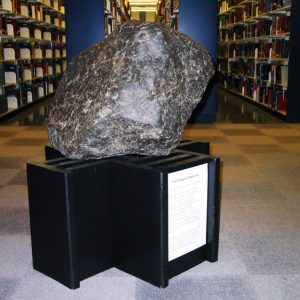calsfoundation@cals.org
Paragould Meteorite
Two, possibly three, huge rocks from outer space put the Arkansas town of Paragould (Greene County) into the history and science books early in 1930. What is now known as the Paragould Meteorite was, at that time, the largest meteorite to ever have been seen falling and then recovered.
A belt of rocks known as the asteroid belt, left over from the formation of the solar system, orbits the sun mainly between the orbits of planets Mars and Jupiter. Due to the gravity of nearby Jupiter, some of these rocks can stray inward and cross Earth’s orbit, even striking it. At 4:08 a.m. on February 17, 1930, the orbit of one of these rocks crossed Earth’s orbit, and two fields southwest of Paragould were struck. The meteor broke into either two or three pieces sometime before striking the ground. Three sonic booms were heard, indicating three pieces. The fireball of the meteor’s entry into Earth’s atmosphere was seen throughout the central United States, including in Indiana, Illinois, Missouri, and Kansas. Reports of a “crashing aircraft” came in from St. Louis, Missouri; Vandalia, Illinois; Mexico and Poplar Bluff, Missouri; and Burlingame, Kansas. Residents in Arkansas and Missouri noticed the sky lighting up, followed by a thunderous quake of the earth when it hit. Livestock stampeded, and nearly everyone in Paragould awoke.
The largest of the meteorite’s pieces was over 800 pounds (370 kilograms), which, by itself, is currently the second-largest meteorite observed in its descent and later recovered. The larger rock fell southwest of Finch (Greene County), measured 16×41 inches (40×105 centimeters), and created a nine-foot hole. Clay flew 100 yards from this impact. In 1930, the larger piece was the largest meteorite in the history of the world to be seen in its descent and the largest stony meteoroid in the world. After a search in the area, it was found by W. H. Hodges, four weeks after the fall, on the farm of Joe H. Fletcher, south of Bethel Church, off Highway 358. It took five men and a team of horses three hours to remove it. Harvey H. Nininger, an aspiring meteorite collector and professor from McPherson, Kansas, bought the larger stone from Fletcher, bidding $3,600; he later sold it to Stanley Field, the president of the Field Museum of Natural History in Chicago, Illinois, for $6,200, and Field donated it to the museum. The money from the sale enabled Nininger to eventually become the most successful meteorite hunter of the century. The 820-pound sample was moved to the University of Arkansas (UA) Library in 1988, where it was displayed on permanent loan. It was moved on April 11, 2008, and displayed at UA’s Arkansas Center for Space and Planetary Science at the Old Museum Building on the Fayetteville (Washington County) campus.
The smaller piece, found by farmer Raymond Parkinson, created a two-foot-deep hole behind the Finch Baptist Church. Weighing seventy-three pounds (thirty-three kilograms), it is now at the U.S. National Museum in Washington DC. It had been on loan to a local high school teacher, L. V. Rhine, who sold it. The two impacts, off the same original piece, were separated by about three miles. A third sonic boom was heard that morning, but a third rock has never been found.
The Paragould meteorites are a rare type of LL5 Chondrite, almost totally stone, as opposed to the other two types of meteorites—irons and stony-irons. The 820-pound portion of the meteorite is the fourth-largest stony meteorite in the world and the third-largest intact specimen.
Besides the largest stone, other parts of the larger sample are in collections of researchers worldwide, such as the Max Planck Institute in Germany, the Smithsonian Institution, Harvard University, and the American Museum of Natural History in New York. Attempts had been made, over the years, by various citizens of Paragould to bring the larger meteorite back to Greene County and build a museum for it. In 2023, the meteorite was returned to Paragould and placed on display in the Greene County Museum.
Other, much smaller, meteorites have fallen at various times in Arkansas, most prominently east of Batesville (Independence County) and at Slovak (Prairie County).
For additional information:
“Paragould.” Buseck Center for Meteorite Studies, Arizona State University. https://meteorites.asu.edu/meteorites/paragould (accessed May 30, 2022).
Renshaw, Kenneth. “Area Marks 75th Anniversary of the Paragould Meteorite.” Paragould Daily Press. February 17, 2005, pp. 1, 2.
Sears, Derek W. G. Thunderstones—A Study of Meteorites Based on Falls and Finds in Arkansas. Fayetteville: University of Arkansas Press, 1988.
Snider, Nan Harrell. “Paragould Meteorite of 1930.” Country Chronicles, November 1993, 3–5.
Kenneth Renshaw
NASA Solar System Ambassadors Program
 Early Twentieth Century, 1901 through 1940
Early Twentieth Century, 1901 through 1940 Science and Technology
Science and Technology Paragould Meteorite
Paragould Meteorite 



My mother, Nora (Starnes) Arnold, told me how she remembered being awakened by the meteorite early that morning. She lived about five miles northwest of the town of Marmaduke in Greene County, Arkansas. Dad, Buren Arnold, lived in the same area, and he remembered everyone talking about where it landed and how the people hauled it out with horses and a farm wagon.
I agree that the Finch meteorites should come home and not be over there at Fayetteville. How radioactive can Triolites be?